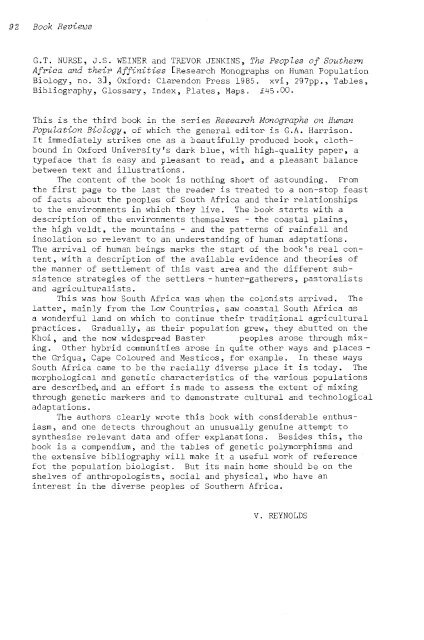CONTENTS NO.I - Institute of Social and Cultural Anthropology ...
CONTENTS NO.I - Institute of Social and Cultural Anthropology ...
CONTENTS NO.I - Institute of Social and Cultural Anthropology ...
Create successful ePaper yourself
Turn your PDF publications into a flip-book with our unique Google optimized e-Paper software.
92 Book Reviews<br />
G.T. NURSE, J.S. WEINER <strong>and</strong> TREVOR JENKINS, The Peoples <strong>of</strong> Southern<br />
Africa <strong>and</strong> their Affinities [Research Monographs on Human Population<br />
, no. 3], Oxford: Clarendon Press 1985. xvi, 297pp., Tables,<br />
Bibliography, Glossary, Index, Plates, £45.00.<br />
This is the third book in the series Research Monographs on Human<br />
Population Biology, <strong>of</strong> which the general editor is G.A. Harrison.<br />
It immediately strikes one as a beautifully produced book, clothbound<br />
in Oxford University's dark blue, with high-quality paper, a<br />
typeface that is easy <strong>and</strong> pleasant to read, <strong>and</strong> a balance<br />
between text <strong>and</strong> illustrations.<br />
The content <strong>of</strong> the book is nothing short <strong>of</strong> astounding. From<br />
the first page to the last the reader is treated to a non-stop feast<br />
<strong>of</strong> facts about the peoples <strong>of</strong> South Africa <strong>and</strong> their relationships<br />
to the environments in which they live. The book starts with a<br />
description <strong>of</strong> the environments themselv.es - the coastal plains,<br />
the high veldt, the mountains - <strong>and</strong> the patterns <strong>of</strong> rainfall <strong>and</strong><br />
insolation so relevant to an underst<strong>and</strong>ing <strong>of</strong> human<br />
The arrival <strong>of</strong> human marks the start <strong>of</strong> the book's real content,<br />
with a description <strong>of</strong> the available evidence <strong>and</strong> theor'ies <strong>of</strong><br />
the manner <strong>of</strong> settlement <strong>of</strong> this vast area <strong>and</strong> the different subsistence<br />
<strong>of</strong> the settlers - , pastoralists<br />
<strong>and</strong> agriculturalists.<br />
This was how South Africa was when the colonists arrived. The<br />
latter, from the Low Countries, saw coastal South Africa as<br />
a wonderful l<strong>and</strong> on which to continue their traditional agricultural<br />
practices. Gradually, as their population grew, they abutted on the<br />
Khoi, <strong>and</strong> the now ,widespread Baster peoples arose through mixing.<br />
Other hybrid communities arose in quite other ways <strong>and</strong><br />
the Griqua, Coloured <strong>and</strong> Mesticos, for In these ways<br />
South Africa came to be the racially diverse it is today. The<br />
morphological <strong>and</strong> characteristics <strong>of</strong> the various populations<br />
are describe~<strong>and</strong> an effort is made to assess the extent <strong>of</strong> mixing<br />
through genetic markers <strong>and</strong> to demonstrate cultural <strong>and</strong> technological<br />
adaptations.<br />
The authors wrote this book with considerable enthusiasm,<br />
<strong>and</strong> one detects throughout an unusually genuine attempt to<br />
synthesise relevant data <strong>and</strong> <strong>of</strong>fer explanations. Besides this, the<br />
book is a compendium, <strong>and</strong> the tables <strong>of</strong> polymorphisms <strong>and</strong><br />
the extensive bibliography will make it a useful work <strong>of</strong> reference<br />
fot the population<br />
But its main home should be on the<br />
shelves <strong>of</strong> anthropologists, social <strong>and</strong> physical, who have an<br />
interest in the diverse peoples <strong>of</strong> Southern Africa.<br />
V. REY<strong>NO</strong>LDS

















